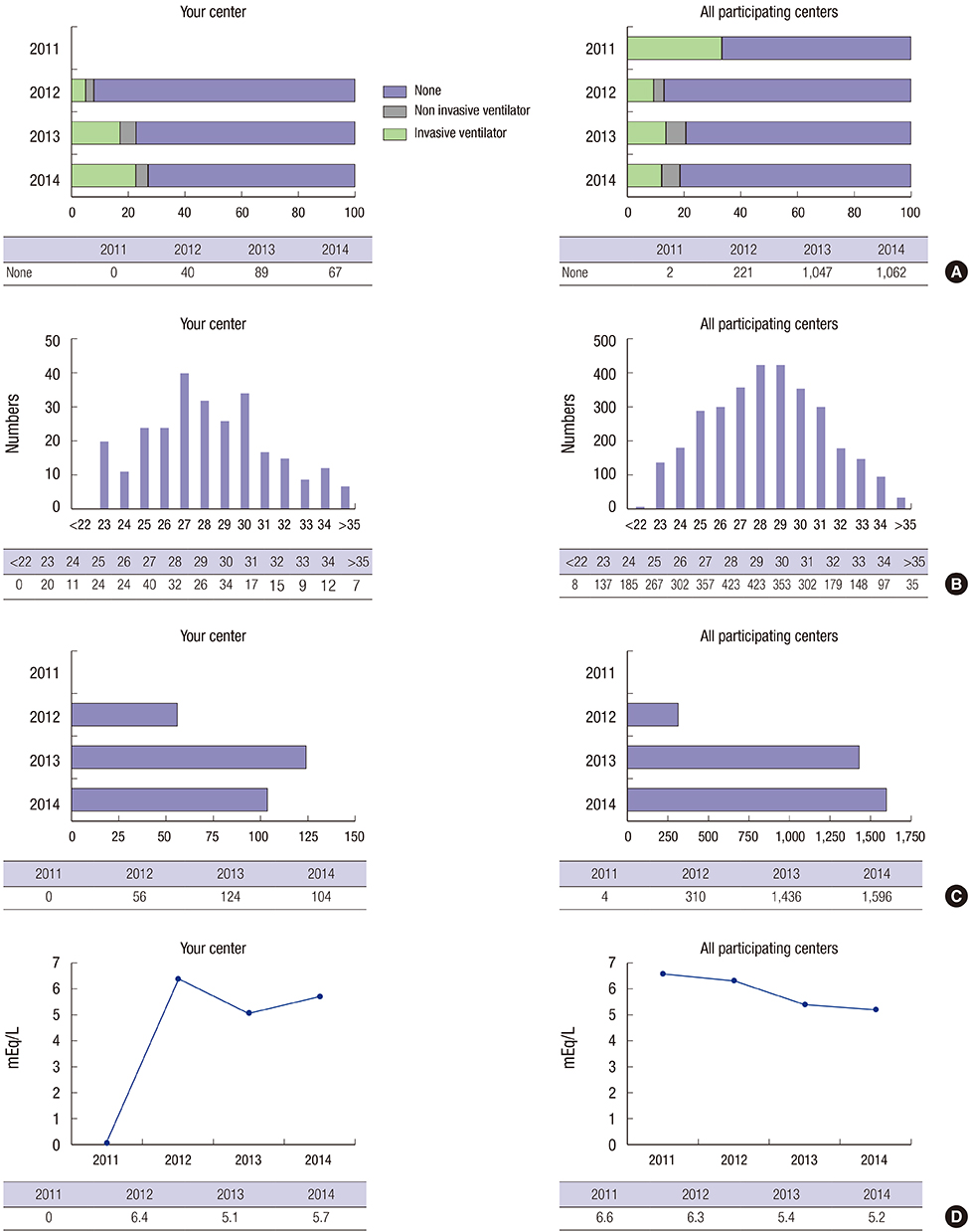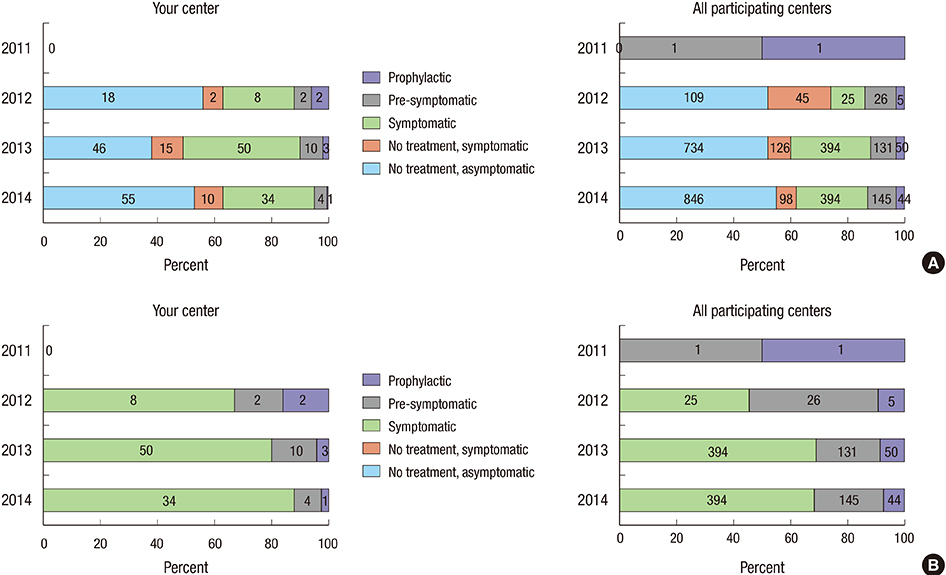J Korean Med Sci.
2015 Oct;30(Suppl 1):S12-S18. 10.3346/jkms.2015.30.S1.S12.
Real-time Data Display System of the Korean Neonatal Network
- Affiliations
-
- 1Department of Pediatrics, University of Ulsan College of Medicine, Asan Medical Center, Seoul, Korea.
- 2Bethesda Soft, Seoul, Korea.
- 3Department of Pediatrics, Ewha Womans University School of Medicine, Seoul, Korea. pea8639@ewha.ac.kr
- KMID: 2351131
- DOI: http://doi.org/10.3346/jkms.2015.30.S1.S12
Abstract
- Real-time data reporting in clinical research networks can provide network members through interim analyses of the registered data, which can facilitate further studies and quality improvement activities. The aim of this report was to describe the building process of the data display system (DDS) of the Korean Neonatal Network (KNN) and its basic structure. After member verification at the KNN member's site, users can choose a variable of interest that is listed in the in-hospital data statistics (for 90 variables) or in the follow-up data statistics (for 54 variables). The statistical results of the outcome variables are displayed on the HyperText Markup Language 5-based chart graphs and tables. Participating hospitals can compare their performance to those of KNN as a whole and identify the trends over time. Ranking of each participating hospital is also displayed in terms of key outcome variables such as mortality and major neonatal morbidities with the names of other centers blinded. The most powerful function of the DDS is the ability to perform 'conditional filtering' which allows users to exclusively review the records of interest. Further collaboration is needed to upgrade the DDS to a more sophisticated analytical system and to provide a more user-friendly interface.
MeSH Terms
Figure
Cited by 1 articles
-
Future of neonatology in Korea: the way forward
Yun Sil Chang
J Korean Med Assoc. 2016;59(7):506-513. doi: 10.5124/jkma.2016.59.7.506.
Reference
-
1. Hack M, Horbar JD, Malloy MH, Tyson JE, Wright E, Wright L. Very low birth weight outcomes of the National Institute of Child Health and Human Development Neonatal Network. Pediatrics. 1991; 87:587–597.2. Horbar JD. The Vermont-Oxford Neonatal Network: integrating research and clinical practice to improve the quality of medical care. Semin Perinatol. 1995; 19:124–131.3. Shah PS, Lee SK, Lui K, Sjörs G, Mori R, Reichman B, Håkansson S, Feliciano LS, Modi N, Adams M, et al. The International Network for Evaluating Outcomes of very low birth weight, very preterm neonates (iNeo): a protocol for collaborative comparisons of international health services for quality improvement in neonatal care. BMC Pediatr. 2014; 14:110.4. Thakkar M, O'Shea M. The role of neonatal networks. Semin Fetal Neonatal Med. 2006; 11:105–110.5. Horbar JD, Soll RF, Edwards WH. The Vermont Oxford Network: a community of practice. Clin Perinatol. 2010; 37:29–47.6. Sankaran K, Chien LY, Walker R, Seshia M, Ohlsson A. Canadian Neonatal Network. Variations in mortality rates among Canadian neonatal intensive care units. CMAJ. 2002; 166:173–178.7. Rüegger C, Hegglin M, Adams M, Bucher HU. Swiss Neonatal Network. Population based trends in mortality, morbidity and treatment for very preterm- and very low birth weight infants over 12 years. BMC Pediatr. 2012; 12:17.8. Kusuda S, Fujimura M, Uchiyama A, Totsu S, Matsunami K. Neonatal Research Network Japan. Trends in morbidity and mortality among very-low-birth-weight infants from 2003 to 2008 in Japan. Pediatr Res. 2012; 72:531–538.9. Adams M, Hoehre TC, Bucher HU. Swiss Neonatal Network. The Swiss Neonatal Quality Cycle, a monitor for clinical performance and tool for quality improvement. BMC Pediatr. 2013; 13:152.10. Kusuda S, Fujimura M, Sakuma I, Aotani H, Kabe K, Itani Y, Ichiba H, Matsunami K, Nishida H. Neonatal Research Network Japan. Morbidity and mortality of infants with very low birth weight in Japan: center variation. Pediatrics. 2006; 118:e1130–e1138.11. Shah V, Warre R, Lee SK. Quality improvement initiatives in neonatal intensive care unit networks: achievements and challenges. Acad Pediatr. 2013; 13:S75–S83.12. Rikli J, Hegwood P, Atwater A, Bauman B, Brown BB, Carteaux P, Hartmann E, Hilton S, Michael L, Norton L, et al. Implementation and case-study results of potentially better practices for staffing in neonatal intensive care units. Pediatrics. 2006; 118:S141–S146.
- Full Text Links
- Actions
-
Cited
- CITED
-
- Close
- Share
- Similar articles
-
- Neonatal Research Network of Japan and Neonatal Database
- The Korean Neonatal Network: An Overview
- Development of Multichannel On-line Thermometry System
- The Implementation of Homecare Nursing Network System Using Wireless Network
- The Design Of Multimedia Emergency Telemedicine System Between Inter-Hospital






